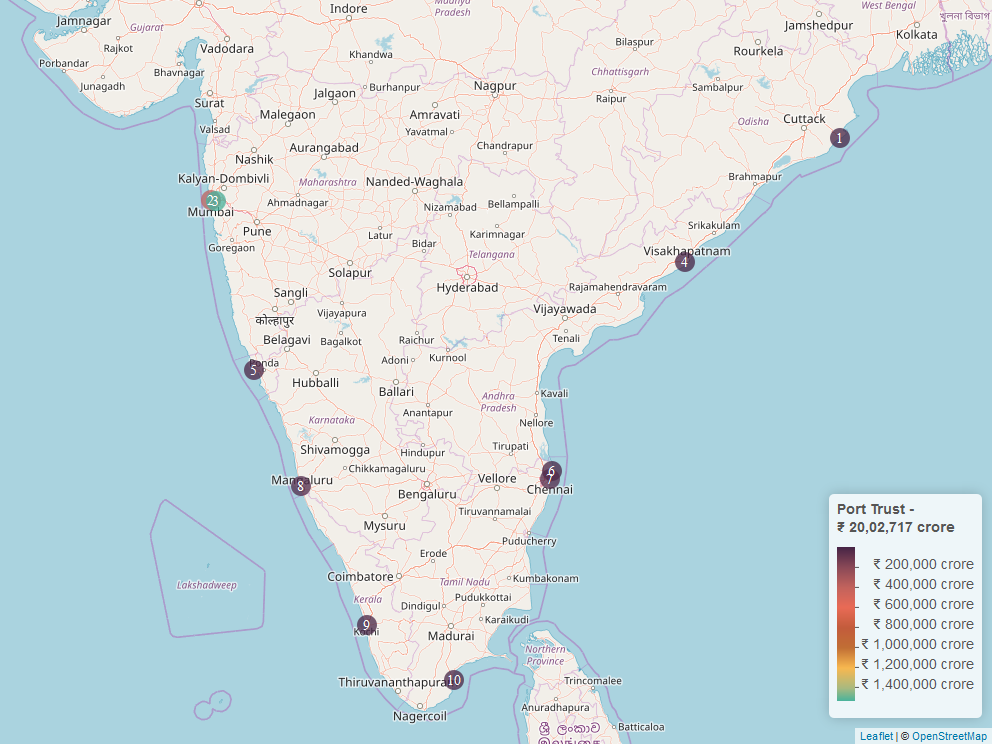Port Trusts
India’s major port trusts are located in or near cities or urban centres. Major Ports Trusts hold more than 100,000 hectares of land, some 6,300 hectares of which is vacant,unneeded for future port operations, and located near key urban areas. India has 13 Major Ports. Twelve are organised under the Major Ports Trust Act (1963). Major Port Trusts report to the central Ministry of Shipping. Frequent controversy arise because of land use and land leasing of the Ports. In addition to the Major Ports, there are some 200 state-government and private ports. Both the private port sector and minor ports are growing faster.[1]
The Bombay Port Trust was established in 1873; the Calcutta Port Trust was established in 1890. The old ports are poorly suited for today’s needs. They are over-staffed by such measures as worker-days per container ship handled or worker-days per 100 tons of bulk cargo (Rajasekar and Deo, 2011). Dock facilities often are mis-matched with today’s mix of cargo, with berths specialized for handling cargo that figured more prominently in shipping decades ago. 2 Kolkata Port Trust, for example, has more than 30,000 pensioners, and a pension fund deficit of 3,000 crore.
Landholding - The Major Ports hold more than 250,000 acres of public land. The largest part of the total consists of tidal land at Kandla Port
| Major Ports | Occupied Area |
|---|---|
| Paradip | 534 Acres |
| Visakhapatnam | 587 Acres |
| Ennore | 1,047 Acres |
| Mumbai | 1859 Acres |
| Chennai | 2035 Acres |
| Tuticorin | 2132 Acres |
| Cochin | 2353 Acres |
| New Manglore | 2928 Acres |
| Mormugao | 6382 Acres |
| Jawaharlal Nehru | 7576 Acres |
| Kolkata | 3000 Acres |
| Haldia | 7000 Acres |
| Kandla | 220416 Acres |
| Total | 257,000 Acres |
In 2010, the Land Policy for Major Ports, developed by inter-ministerial committee and administered by the Shipping Ministry. This Policy amends the Major Ports Land Policy established in 2004. It was shaped in part by Supreme Court rulings regarding leasing rates for commercial land leased by Major Ports. In July 2012 the Policy was further modified by central government instruction to limit local Port Trust Boards discretion in land allocation. Although the 2010 Land Policy represents a major step forward in port land management, it has shortcomings that have led to various disputes. Many The case studies reveal several examples of favoritism in land allocation. Another issue has concerned the amount of power that should be given to local Port Trust Boards for long-term alienation of public land, either through long-term lease or sale. The 2010 regulations allow Major Port Trust Boards to enter into 30-year land leases on their own. A third area of dispute involves application of the new land pricing rules to existing lease. contracts. After Land Policy came into existence Major Port Trusts have been given a clear mandate to plan for land use. At the same time many decisions about identifying surplus lands referred to the Central Government.
Mumbai Port Trust Mumbai Port Trust owns most valuable land in India. It's 808.92 hectares which form about one sixth of the total island which have great financial value. As a port Mumbai has been relative decline for 30 years. In the 1980's It is the most active port by volume of cargo handled. It has now slipped to 6th or 7th place among major ports. in 2010-11 the port posted a net deficit of Rs. 438 crores. The modern facilities at Jawaharlal Nehru Port (JNPT) give it a competitive edge.
Mumbai Port Trust's land leases from Taj Mahal Hotel and Royal Bombay Yacht Club to abandoned textile mills and half warehouses of cotton green. Major land of Ballard Estate is a Mumbai Port Trust's landholding. Mumbai Port Trust had over 2900 leases across 2466 tenants as of August 1, 2011. According to the Mumbai Port Trust's website, total land of MPBT leased to Central government is 131 hectares, to the State government- 4.7 hectares and to the Private parties - 138 Hectares. It is estimated that MPBT is able to collect about 30 percent of its billed rent. After accounting for operating and other costs the net surplus from estate activity amounted to Rs 18.25 crores in 2010-11. As on September 2002, there were 1900 cases pending in various courts. Many of the leases which have expired have not been renewed. In many cases MBPT receives no rent. There are political and intra governmental disputes over Mbpt landholdings holding back the development and use of Mumbai Port Trust's land. Mumbai Port Trust’s land operations are non-transparent. The Port Trust has not prepared a Land Use Plan as required by national policy. Centrally-controlled institutions rarely volunteer that they have surplus land. However, central-level policy should give equal weight to the economic loss caused by having valuable land assets sit vacant or underutilized for decades. A clear statement by Cabinet that urban land is a scarce and valuable resource; that central landholding institutions are expected to identify land required for their present and future service provision; that remaining land is to be classified as “surplus”; and that institutions are expected to prepare and implement plans for monetizing surplus land. Step has taken for creation of a annual central Land Audit. Incorporation of proceeds from land disposition in five year financing plans. The single step that could most help rationalize management of public lands is greater transparency and accountability. The lack of publicly available information permits corrupt land dealings to occur.
References
- ↑ Patricia Clarke Annez Shubhashis Gangopadhyay, ed. India’s Public Lands: Responsive, Transparent, and Fiscally Responsible Asset Management. Report. 1-253.
